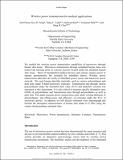Wireless power transmission for medical applications
Author(s)
Payne, Joshua E.; Song, Kyo D.; Yang, Sang Y.; Kim, Jaehwan; Park, Yeonjoon; Choi, Sang H.; ... Show more Show less
DownloadPayne-2009-Wireless power transmission for medical applications.pdf (331.5Kb)
PUBLISHER_POLICY
Publisher Policy
Article is made available in accordance with the publisher's policy and may be subject to US copyright law. Please refer to the publisher's site for terms of use.
Terms of use
Metadata
Show full item recordAbstract
We studied the wireless power transmission capabilities of microwave through human skin-tissue. Microwave transmission through simulated human skins was tested with rectenna array as a power receiver located under the simulated human skin tissue. Most of transplanted medical devices and sensors require power to operate autonomously but currently by imbedded battery. Wireless power transmission alleviates the needs of imbedded power source and hard-wire power network. We used human skin-like materials, such as various polyurethanes and pork skin, under X-band microwave exposure. Transmission rate through various polyurethanes under the threshold limit value (TLV) and dielectric constant was measured in this experiment. It is also critical to measure specific absorption rates (SAR) of polyurethanes and transmission rates through polyurethanes as well as pork skin. This paper presents power transmission rates under varying thickness of polyurethanes, and effectiveness and efficiency of rectennas under the TLV of microwave power. In addition, we will discuss milimeter wave thermograph and hazards the absorption characteristics of human skin under 8-13 GHz using the results of polyurethanes and pork skin.
Date issued
2009-04Department
Massachusetts Institute of Technology. Department of Nuclear Science and EngineeringJournal
Proceedings of SPIE--the International Society for Optical Engineering
Publisher
Society of Photo-Optical Instrumentation Engineers
Citation
Payne, Josh et al. “Wireless power transmission for medical applications.” Nanosensors, Biosensors, and Info-Tech Sensors and Systems 2009. Ed. Vijay K. Varadan. San Diego, CA, USA: SPIE, 2009. 72910X-9. © 2009 SPIE
Version: Final published version
Other identifiers
SPIE CID: 72910X-9
ISSN
0277-786X